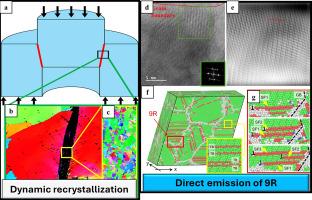Enhanced dynamic shear properties of FeNiCoAl-based high-entropy alloy by activation of partial-related structures
IF 14.3
1区 材料科学
Q1 MATERIALS SCIENCE, MULTIDISCIPLINARY
引用次数: 0
Abstract
Nanoscale twins and a 9R structure (a periodically faulted rhombohedral configuration) were directly observed under microscopy in a medium/high stacking-fault energy face-centered cubic high-entropy alloy (HEA) subjected to high strain rate shear deformation, and demonstrated to be related to a special activity of partial dislocations, namely, the cooperative activation of partial dislocations, which is manifested by detwinning when the alloy is subjected to conditions that involve a high local stress at a high strain rate. These mechanisms significantly enhance work-hardening behavior, providing a new pathway for designing high-toughness HEAs. Furthermore, the significant grain refinement associated with dynamic recrystallization increases the likelihood of partial-dislocation-related defects. This promotes the direct formation of the 9R phase through the sequential activation of partial dislocations from grain boundaries, leading to continuous strain hardening following the onset of shear localization. The corresponding formation mechanisms are elucidated through molecular dynamics simulations.

通过激活部分相关结构增强fenical基高熵合金的动态剪切性能
在显微镜下直接观察到中/高层叠-断层能面心立方高熵合金(HEA)在高应变速率剪切变形下的纳米孪晶和9R结构(周期性断裂的菱形构形),并证明了这与部分位错的特殊活动有关,即部分位错的协同激活。当合金处于高应变率下的高局部应力条件下时,这表现为脱孪。这些机制显著提高了加工硬化行为,为高韧性HEAs的设计提供了新的途径。此外,与动态再结晶相关的显著晶粒细化增加了部分位错相关缺陷的可能性。这通过晶界部分位错的顺序激活促进了9R相的直接形成,导致剪切局部化发生后的连续应变硬化。通过分子动力学模拟,阐明了相应的形成机理。
本文章由计算机程序翻译,如有差异,请以英文原文为准。
求助全文
约1分钟内获得全文
求助全文
来源期刊

Journal of Materials Science & Technology
工程技术-材料科学:综合
CiteScore
20.00
自引率
11.00%
发文量
995
审稿时长
13 days
期刊介绍:
Journal of Materials Science & Technology strives to promote global collaboration in the field of materials science and technology. It primarily publishes original research papers, invited review articles, letters, research notes, and summaries of scientific achievements. The journal covers a wide range of materials science and technology topics, including metallic materials, inorganic nonmetallic materials, and composite materials.
 求助内容:
求助内容: 应助结果提醒方式:
应助结果提醒方式:


